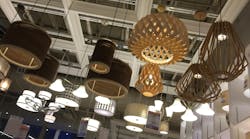Courtesy of www.MikeHolt.com.
All questions and answers are based on the 2023 NEC.
Q1: Article 410 covers luminaires, portable luminaires, lampholders, pendants, incandescent filament lamps, arc lamps, electric-discharge lamps, and _____, and the wiring and equipment forming part of such products and lighting installations.
a) decorative lighting products
b) lighting accessories for temporary seasonal and holiday use
c) portable flexible lighting products
d) all of these
Q2: Where one or more internal cable clamps are present in the box, a single volume allowance shall be made based on the _____ present in the box.
a) largest conductor
b) smallest conductor
c) average conductor size
d) number of devices
Q3: Thermal insulation shall not be installed above a recessed luminaire or within _____ of the recessed luminaire’s enclosure or wiring compartment unless the luminaire is identified as Type IC.
a) 1 in.
b) 1¼ in.
c) 1½ in.
d) 3 in.
Q4: Tap connections to a common grounding electrode conductor for multiple separately derived systems may be made to a copper or aluminum busbar that is _____ and of sufficient length to accommodate the number of terminations necessary for the installation.
a) smaller than ¼ in. thick × 4 in. wide
b) not smaller than ¼ in. thick × 2 in. wide
c) not smaller than ½ in. thick × 2 in. wide
d) not smaller than ¼ in. thick × 2½ in. wide
Q5: Where required in Art. 680, ground-fault protection of receptacles and outlets on branch circuits rated 150V or less to ground and _____ or less, single- or 3-phase, shall be provided with a Class A GFCI.
a) 20A
b) 30A
c) 40A
d) 60A
Q6: Where the motor short-circuit and ground-fault protection devices determined by Table 430.52(C)(1) do not correspond to the standard sizes or ratings, a _____ rating that does not exceed the next _____ standard ampere rating is permitted.
a) higher
b) lower
c) smaller
d) larger
Answers:
Q1: d) all of these
Section 410.1 states, "This article covers luminaires, portable luminaires, lampholders, pendants, incandescent filament lamps, arc lamps, electric-discharge lamps, decorative lighting products, lighting accessories for temporary seasonal and holiday use, portable flexible lighting products, and the wiring and equipment forming part of such products and lighting installations."
Q2: a) largest conductor
As stated in Sec. 314.16(B)(2), "Where one or more internal cable clamps, whether factory or field supplied, are present in the box, a single volume allowance in accordance with Table 314.16(B)(1) shall be made based on the largest conductor present in the box."
Q3: d) 3 in.
Section 410.116(B) confirms, "Thermal insulation shall not be installed above a recessed luminaire or within 3 in. of the recessed luminaire’s enclosure, wiring compartment, ballast, transformer, LED driver, or power supply unless the luminaire is identified as Type IC for insulation contact."
Q4: b) not smaller than ¼ in. thick × 2 in. wide
According to Sec. 250.30(A)(6)(c)(2), "Listed connections to aluminum or copper busbars not smaller than ¼ in. thick × 2 in. wide and of a length to accommodate the number of termination necessary for the installation."
Q5: d) 60A
Per Sec. 680.5(B): "Where required in this article, ground-fault protection of receptacles and outlets on branch circuits rated 150V or less to ground and _____ or less, single- or three-phase, shall be provided with a Class A GFCI."
Q6: a) higher
As stated in Sec. 430.52(C)(1)(a), "Where the values as determined by Table 430.52(C)(1) do not correspond to the standard ampere ratings and setting provided in 240.6, the next higher standard rating or setting shall be permitted."
These materials are provided by Mike Holt Enterprises in Leesburg, Fla. To view Code training materials offered by this company, visit www.mikeholt.com/code.




